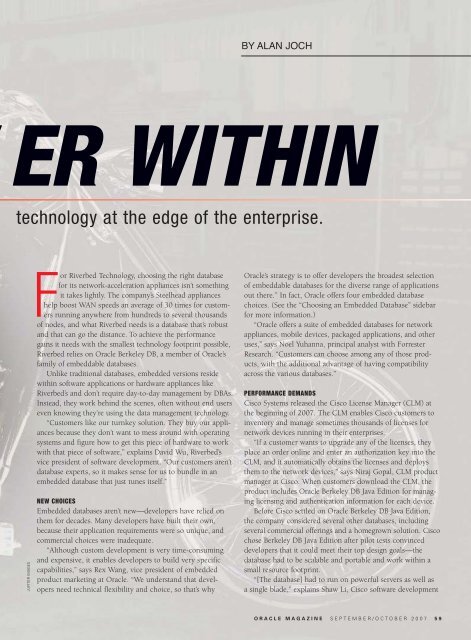Oracle Magazine - September/October 2007 - Marcelo Machado
Oracle Magazine - September/October 2007 - Marcelo Machado
Oracle Magazine - September/October 2007 - Marcelo Machado
You also want an ePaper? Increase the reach of your titles
YUMPU automatically turns print PDFs into web optimized ePapers that Google loves.
ER WITHIN<br />
technology at the edge of the enterprise.<br />
JUPITER IMAGES<br />
or Riverbed Technology, choosing the right database<br />
for its network-acceleration appliances isn’t something<br />
it takes lightly. The company’s Steelhead appliances<br />
help boost WAN speeds an average of 30 times for customers<br />
running anywhere from hundreds to several thousands<br />
of nodes, and what Riverbed needs is a database that’s robust<br />
and that can go the distance. To achieve the performance<br />
gains it needs with the smallest technology footprint possible,<br />
Riverbed relies on <strong>Oracle</strong> Berkeley DB, a member of <strong>Oracle</strong>’s<br />
family of embeddable databases.<br />
Unlike traditional databases, embedded versions reside<br />
within software applications or hardware appliances like<br />
Riverbed’s and don’t require day-to-day management by DBAs.<br />
Instead, they work behind the scenes, often without end users<br />
even knowing they’re using the data management technology.<br />
“Customers like our turnkey solution. They buy our appliances<br />
because they don’t want to mess around with operating<br />
systems and figure how to get this piece of hardware to work<br />
with that piece of software,” explains David Wu, Riverbed’s<br />
vice president of software development. “Our customers aren’t<br />
database experts, so it makes sense for us to bundle in an<br />
embedded database that just tunes itself.”<br />
NEW CHOICES<br />
Embedded databases aren’t new—developers have relied on<br />
them for decades. Many developers have built their own,<br />
because their application requirements were so unique, and<br />
commercial choices were inadequate.<br />
“Although custom development is very time-consuming<br />
and expensive, it enables developers to build very specific<br />
capabilities,” says Rex Wang, vice president of embedded<br />
product marketing at <strong>Oracle</strong>. “We understand that developers<br />
need technical flexibility and choice, so that’s why<br />
BY ALAN JOCH<br />
<strong>Oracle</strong>’s strategy is to offer developers the broadest selection<br />
of embeddable databases for the diverse range of applications<br />
out there.” In fact, <strong>Oracle</strong> offers four embedded database<br />
choices. (See the “Choosing an Embedded Database” sidebar<br />
for more information.)<br />
“<strong>Oracle</strong> offers a suite of embedded databases for network<br />
appliances, mobile devices, packaged applications, and other<br />
uses,” says Noel Yuhanna, principal analyst with Forrester<br />
Research. “Customers can choose among any of those products,<br />
with the additional advantage of having compatibility<br />
across the various databases.”<br />
PERFORMANCE DEMANDS<br />
Cisco Systems released the Cisco License Manager (CLM) at<br />
the beginning of <strong>2007</strong>. The CLM enables Cisco customers to<br />
inventory and manage sometimes thousands of licenses for<br />
network devices running in their enterprises.<br />
“If a customer wants to upgrade any of the licenses, they<br />
place an order online and enter an authorization key into the<br />
CLM, and it automatically obtains the licenses and deploys<br />
them to the network devices,” says Niraj Gopal, CLM product<br />
manager at Cisco. When customers download the CLM, the<br />
product includes <strong>Oracle</strong> Berkeley DB Java Edition for managing<br />
licensing and authentication information for each device.<br />
Before Cisco settled on <strong>Oracle</strong> Berkeley DB Java Edition,<br />
the company considered several other databases, including<br />
several commercial offerings and a homegrown solution. Cisco<br />
chose Berkeley DB Java Edition after pilot tests convinced<br />
developers that it could meet their top design goals—the<br />
database had to be scalable and portable and work within a<br />
small resource footprint.<br />
“[The database] had to run on powerful servers as well as<br />
a single blade,” explains Shaw Li, Cisco software development<br />
ORACLE MAGAZINE SEPTEMBER/OCTOBER <strong>2007</strong> 59


